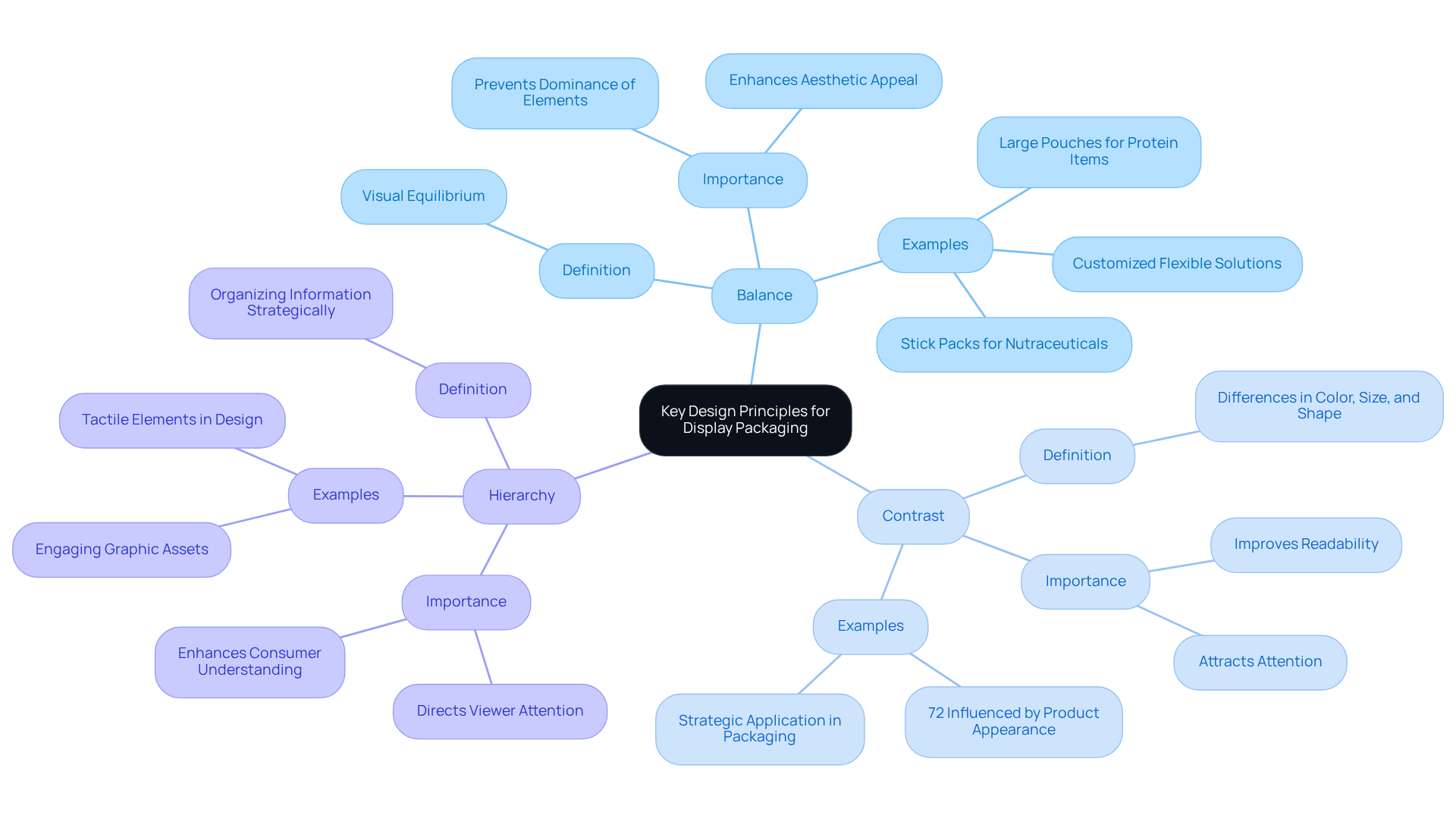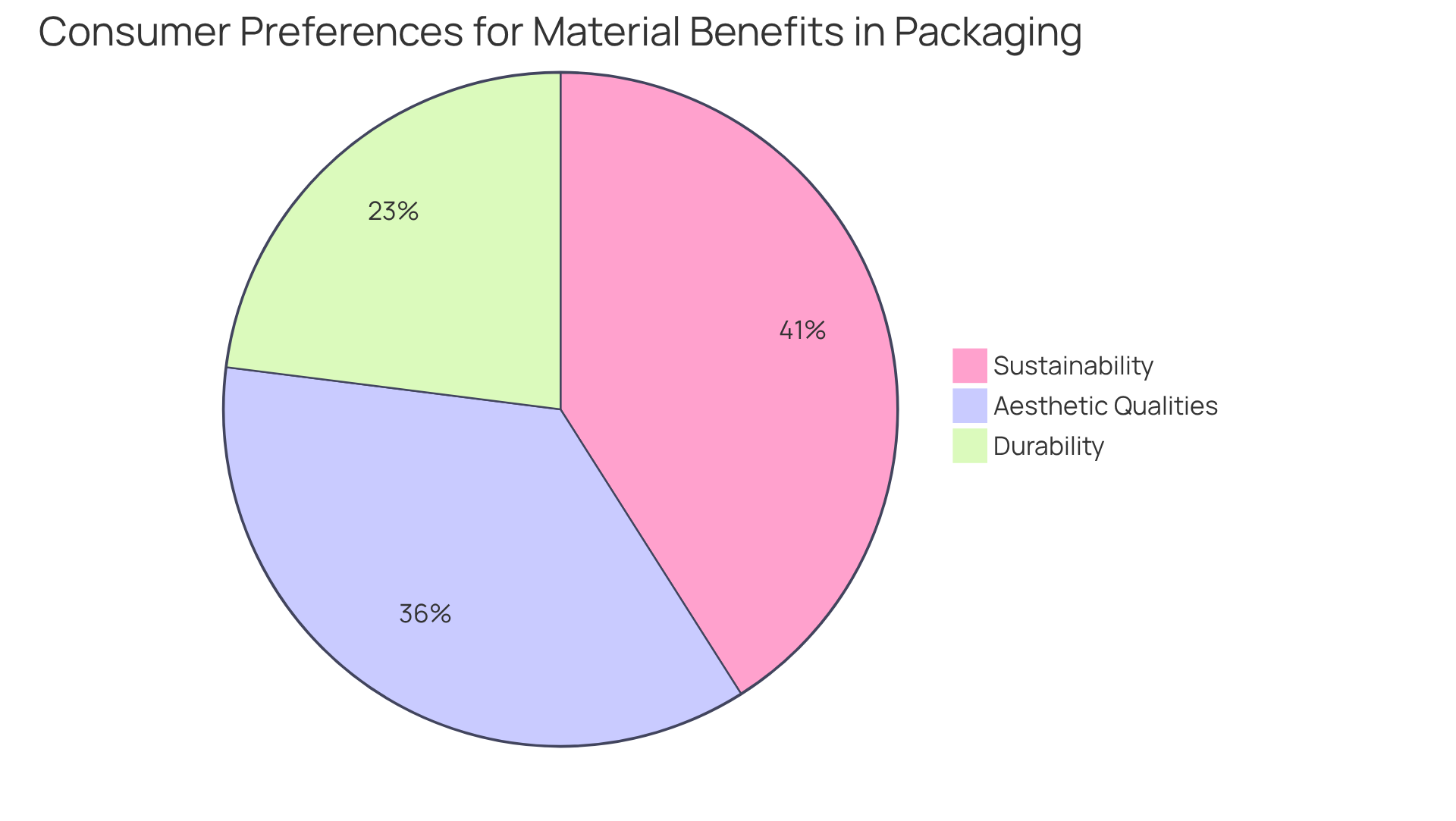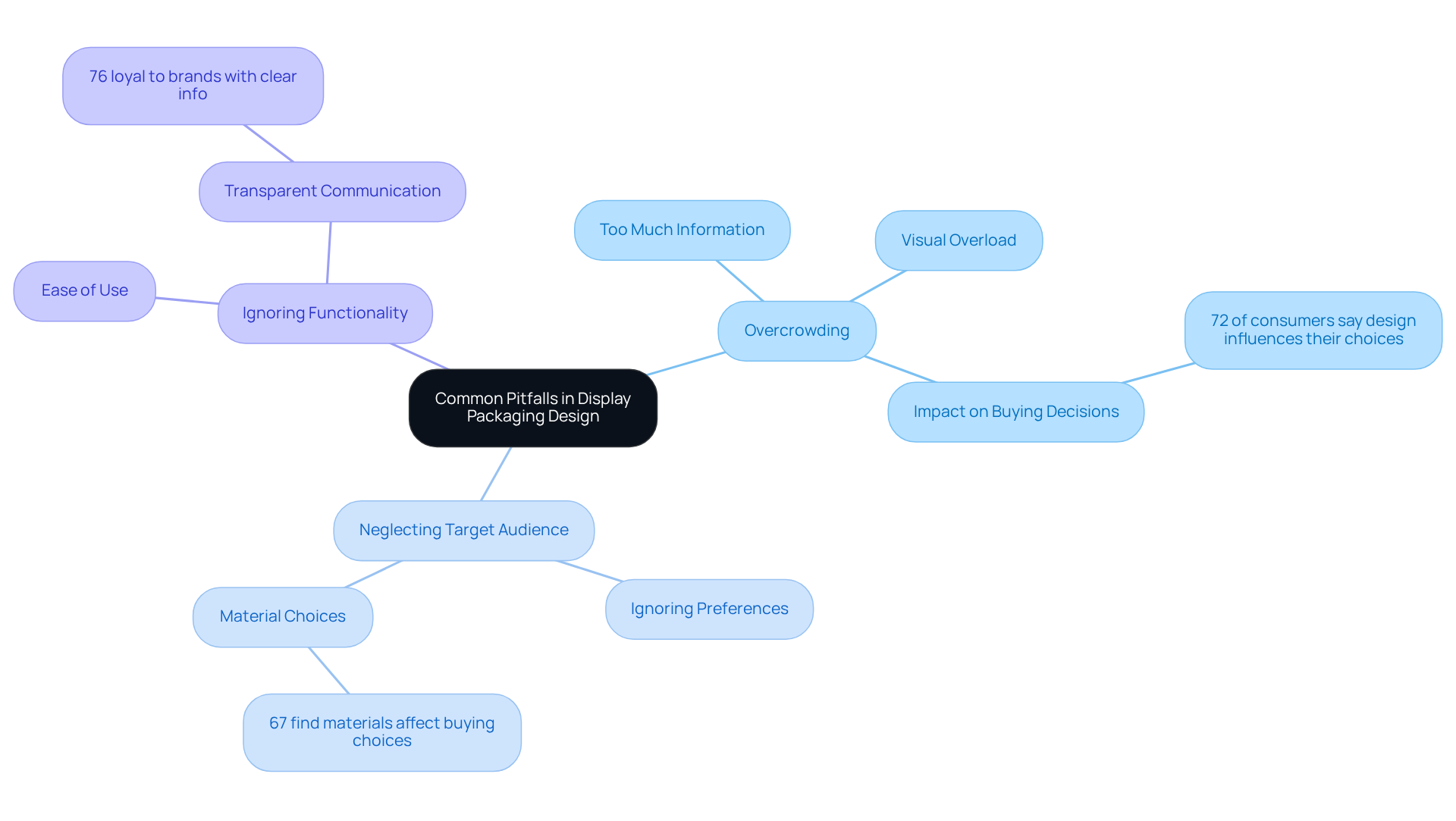Overview
The article outlines four key strategies for effective display packaging design, asserting the critical importance of:
- Balance
- Contrast
- Hierarchy
- Material choice
in enhancing product visibility and consumer engagement. These strategies are substantiated by evidence illustrating that thoughtful design can significantly increase customer interaction and sales. Moreover, it is essential to avoid common pitfalls, such as overcrowding and neglecting the target audience, to ensure the effectiveness of packaging. By implementing these principles, businesses can elevate their packaging solutions to meet consumer needs and drive success.
Introduction
Effective display packaging design is a crucial element in capturing consumer attention and driving sales in a competitive marketplace. By understanding and applying key design principles such as:
- Balance
- Contrast
- Hierarchy
brands can create visually appealing packaging that not only attracts shoppers but also communicates product value effectively. However, the challenge lies in navigating common design pitfalls that can undermine these efforts.
What strategies can brands employ to enhance their display packaging while avoiding these missteps? This inquiry is essential for brands aiming to stand out and succeed.
Understand Key Design Principles for Display Packaging
Effective display packaging design relies on a comprehensive understanding of essential design principles, which include:
-
Balance: Achieving visual equilibrium through the even distribution of elements across the packaging is crucial. A well-balanced design prevents any single component from dominating, resulting in a harmonious appearance that captures the consumer's attention. With Western Packaging's expertise in customized flexible solutions, such as large pouches for protein items and stick packs for nutraceuticals, balance is meticulously achieved, enhancing the overall aesthetic appeal of nutraceutical products.
-
Contrast: The strategic use of differences in color, size, and shape is vital for emphasizing key features of the container. Effective contrast not only attracts attention but also improves readability, ensuring that important information stands out. Research indicates that 72% of individuals are influenced by product appearance, underscoring the importance of contrast in drawing focus. Western Packaging's innovative design solutions can elevate brand recognition through the strategic application of contrast in packaging.
-
Hierarchy: Organizing information in a strategic manner directs the viewer's attention, emphasizing the most essential elements first. A clear hierarchy enables consumers to quickly grasp the product's value and benefits. Nielsen reports that consumers respond positively to designs they can physically interact with, highlighting the importance of tactile elements in establishing hierarchy. Western Packaging's commitment to developing engaging graphic assets ensures that hierarchy is effectively communicated in nutraceutical containers.
Applying these principles can significantly enhance the effectiveness of display packaging. For example, a nutraceutical product could leverage bold colors and clear typography to highlight health benefits, ensuring it stands out on crowded shelves. A case study on efficient container arrangement in the nutraceutical sector revealed that brands employing clear hierarchy and contrast experienced a 30% increase in customer engagement.
Incorporating balance, contrast, and hierarchy into product design, as well as utilizing display packaging, not only enhances visual appeal but also fosters consumer engagement, ultimately driving sales and brand loyalty. Designers must, however, be mindful of common pitfalls, such as overloading containers with information or overlooking the emotional impact of color choices, as these can detract from overall effectiveness.

Explore Different Types of Display Packaging Options
Brands can leverage various forms of display packaging to enhance product visibility and drive sales.
-
Counter Displays: Strategically placed in high-traffic areas, these displays attract impulse buyers by showcasing products at eye level. Their compact design makes them ideal for promoting new nutraceutical supplements, ensuring easy access for users. As Fernando Rico observes, "The manner in which you display your items plays a crucial role in capturing consumer attention."
-
Floor Displays: These larger displays serve as focal points in retail settings, capable of holding multiple items. They are particularly effective for nutraceutical brands aiming to create an immersive shopping experience, drawing attention to a range of offerings in a single location. It is essential to begin placing items onto the shelves from the bottom shelf and work your way up to ensure stability and visibility.
-
End Cap Displays: Positioned at the end of aisles, end cap displays are designed to catch shoppers' eyes and promote special offers. Their strategic positioning enhances item visibility, rendering them a potent instrument for encouraging impulse buys, particularly during busy shopping periods. For instance, a chocolate brand successfully launched a holiday-themed promotion using festive decorations, significantly boosting sales during the holiday period.
Understanding the strengths of each display packaging type allows brands to tailor their marketing strategies effectively. For example, a nutraceutical brand might utilize a counter display for a new supplement launch, while also employing end cap displays to highlight seasonal promotions. By improving display wrapping and ensuring high-quality materials are utilized to safeguard the display unit during transportation, brands can significantly boost their market presence and connect with customers more effectively. Furthermore, it is essential to ensure that heavy items are evenly spread across the shelves to avoid tipping, which can compromise the effectiveness of the display.

Leverage Material Benefits for Enhanced Product Appeal
The choice of materials in display packaging significantly influences item attractiveness and buyer perception. The key benefits of material choices are as follows:
- Sustainability: Eco-friendly materials resonate with environmentally conscious consumers, enhancing brand image and fostering loyalty. Approximately 82% of buyers are willing to pay a premium for sustainable items, indicating a growing demand for eco-friendly materials. This is particularly relevant for nutraceutical manufacturers, as 39% of millennial consumers cite environmental impact as a crucial factor in their purchasing decisions.
- Durability: High-quality materials ensure that containers withstand handling and transportation, preserving item integrity. Sturdy containers are especially vital for nutraceuticals, where effectiveness can be compromised by inadequate protection.
- Aesthetic Qualities: Materials such as textured paper or glossy finishes elevate the perceived value of an item, enhancing its appeal on retail shelves. Research indicates that 72% of buyers believe product appearance influences their purchasing choices, underscoring the importance of aesthetics in presentation. A case study on design impact revealed that 81% of shoppers have purchased a new item due to its attractive presentation.
For instance, employing recycled cardboard for display packaging not only mitigates environmental impact but also appeals to consumers who prioritize sustainability. Brands that effectively leverage these material benefits can devise solutions involving display packaging that not only protect the product but also enhance its marketability, ultimately driving sales and cultivating brand loyalty. Furthermore, material specialists assert, 'The appropriate selection of materials can greatly improve both the longevity and visual appeal of containers, resulting in heightened customer engagement and satisfaction.

Avoid Common Pitfalls in Display Packaging Design
To create effective display packaging, it is essential to avoid common design pitfalls:
-
Overcrowding: Too much information or too many visuals can overwhelm consumers. Aim for a clean, focused layout that captures attention without causing confusion. Research shows that 72% of American consumers claim that design of the containers greatly influences their buying decisions, emphasizing the need for clarity.
-
Neglecting Target Audience: Ignoring the preferences and behaviors of the target audience can result in ineffective presentation. For example, 67% of participants indicated that the materials utilized for wrapping affect their buying choices. Grasping these preferences is essential for designing containers that connect with buyers.
-
Ignoring Functionality: Packaging must not only look good but also serve its purpose effectively. It should be easy to open and use, ensuring a positive user experience. Furthermore, 76% of buyers are more devoted to brands that offer clear information about their offerings, emphasizing the significance of transparent communication in labeling.
By recognizing these pitfalls, brands can create display packaging that is both visually attractive and practical, aligning with buyer expectations. For example, a nutraceutical item should clearly convey its health advantages without overwhelming the layout, ensuring that purchasers can swiftly understand its worth. This method not only improves brand image but also promotes customer loyalty, as 61% of consumers are more inclined to buy luxury products again if they are presented in premium containers. Ultimately, effective packaging design is a strategic investment that can drive sales and elevate brand identity.

Conclusion
Effective display packaging design is a crucial factor in capturing consumer attention and driving sales. By understanding and applying key design principles such as balance, contrast, and hierarchy, brands can create visually appealing packaging that not only attracts buyers but also communicates essential product information clearly. These principles, when executed thoughtfully, can significantly enhance the overall consumer experience and foster brand loyalty.
Throughout this article, various strategies for optimizing display packaging have been explored. From utilizing different types of display options like counter and floor displays to selecting sustainable materials that resonate with environmentally conscious consumers, each element plays a vital role in creating a compelling presentation. Additionally, avoiding common pitfalls such as overcrowding and neglecting target audience preferences is essential for ensuring that packaging effectively serves its purpose while remaining attractive.
Ultimately, the importance of effective display packaging design cannot be overstated. Brands that invest in thoughtful, strategic packaging not only enhance their market presence but also create lasting connections with consumers. As the landscape of retail continues to evolve, embracing innovative display packaging solutions will be key to standing out in a competitive marketplace. By prioritizing design principles and understanding consumer preferences, businesses can craft packaging that not only meets expectations but exceeds them, driving engagement and sales in the long run.
Frequently Asked Questions
What are the key design principles for display packaging?
The key design principles for display packaging include balance, contrast, and hierarchy.
How does balance contribute to effective display packaging design?
Balance achieves visual equilibrium by evenly distributing elements across the packaging, preventing any single component from dominating and creating a harmonious appearance that captures consumer attention.
Why is contrast important in packaging design?
Contrast emphasizes key features through differences in color, size, and shape, attracting attention and improving readability, which ensures that important information stands out.
What impact does hierarchy have on consumer perception of packaging?
Hierarchy organizes information to direct the viewer's attention, allowing consumers to quickly grasp the product's value and benefits, enhancing their interaction with the design.
How can the application of these design principles affect consumer engagement?
Applying balance, contrast, and hierarchy can significantly enhance visual appeal and consumer engagement, as demonstrated by a case study showing a 30% increase in customer engagement for brands that effectively utilized these principles.
What are some common pitfalls to avoid in packaging design?
Common pitfalls include overloading containers with information and overlooking the emotional impact of color choices, which can detract from the overall effectiveness of the design.




